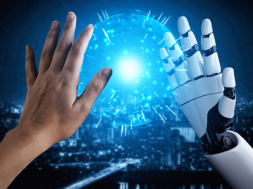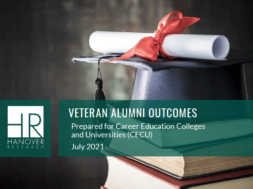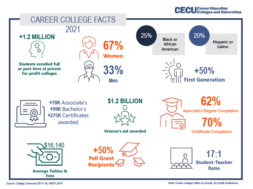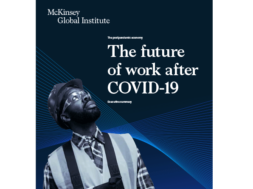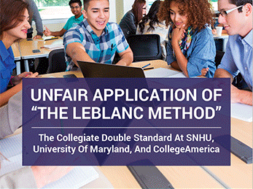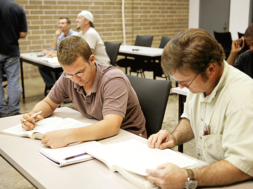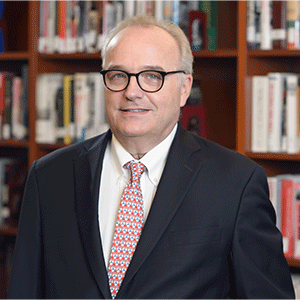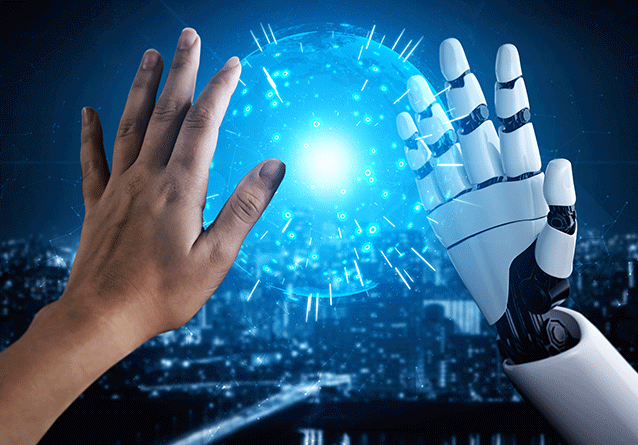
Human Work in the Age of Smart Machines – A Book Review
By Dr. Wallace E. Boston, Jr., President Emeritus, American Public University System
When I read a short blurb about the latest book authored by Lumina CEO Jamie Merisotis, Human Work in the Age of Smart Machines1, I was skeptical that anyone would be able to make an argument that the number of jobs will increase as AI continues to be embraced by more and more companies. After reading and rereading Human Work, I continue to be a skeptic, but I am more of a believer in the methodology proposed by Mr. Merisotis.
In an opening chapter, How Work is Being Transformed, Mr. Merisotis writes that he believes the preoccupation with job loss due to the implementation of AI is misplaced. It would be better, he writes, if we think less about the future of work and more about the work of the future.
What’s more important, Merisotis states, is that everyone will see their jobs change in some way by technology and will need additional learning to take advantage of the opportunities for work that will be created.
In 2020, technology has impacted all occupations in the U.S., with half of all tasks designated “uniquely human” versus just 30 percent designated as such in 2000. Mr. Merisotis writes that projections of these trends indicate that the percentage of tasks designated as “uniquely human” will increase to 80 percent over the next 10 years.
Human work, the work that only people can do, is the work that Mr. Merisotis believes is what our collective future will be based upon. People will need to develop the knowledge, skills, and expertise that human work requires.
For instance, the jobs created will require high-level cognitive skills such as complex problem solving, critical thinking, and creativity. They will also require social intelligence such as the social perceptiveness needed when one is persuading, negotiating, and caring for others.
Globally, nearly half of adults have only a basic ability to solve problems utilizing technology. In the U.S., the number of jobs requiring only a high school diploma has shrunk from 33 percent to 20 percent over the past three decades. Good jobs have increased, but they are going to people with post-secondary credentials.
According to Mr. Merisotis, there are four kinds of occupations emerging that embody human work. These are helpers, bridgers, integrators, and creators.
- Helpers are people in occupations involving deep personal interaction with other people. Customer service roles and many healthcare roles are helping professions.
- Bridgers are people who interact with others, perform technical tasks, and help run systems. Sales managers and many supervisors fall into this category.
- Integrators are people who integrate knowledge and skills from a range of fields and apply them in a highly personal way. Social workers and elementary teachers are excellent examples of Integrators.
- Creators are people who possess highly technical skills and pure creativity. Examples provided by Mr. Merisotis include several entrepreneurs who leveraged technology to build nationwide businesses, which was not possible without harnessing the Internet and other technologies.
Mr. Merisotis outlines the exponential increase in knowledge growth over the past century including the most recent decade of advancement, but writes that knowledge obsolescence is also a factor in careers almost as much as knowledge acquisition is a factor. According to him, there is no way we can prepare people for work using old models of learning based on mastery of knowledge.
We need to change our education systems to embrace wide learning. Three sets of skills will be required for human work: people skills, problem-solving skills, and integrative skills.
Innovations enabled by AI will create new capabilities, products, and services. These innovations will increase the importance of people skills and person-to-person relationships. One people skill that underlies all others, according to Mr. Merisotis, is empathy.
Problem solving is on everyone’s list for future work, but it’s seldom explained because it’s a multi-stage, complex process.
Stage one is identifying or diagnosing the problem, which may require analyzing data, insights from personal interactions, or using whatever other information is available. Solving the problem requires subject matter or technical expertise and the ability to think creatively.
Because of the ever-changing nature of work and the fact that people need to keep learning throughout their lives, the ability to learn is an essential skill for human work. In a world where human work is constantly changing, it’s not either/or.
Everyone needs a combination of general and technical learning. What’s important to human work is integrating them.
According to Mr. Merisotis, human work requires us to rethink every aspect of how we provide everyone the opportunity to learn, because the learner must be at the center of the system. Currently, there are two dominant processes for learning. Workforce training prepares individuals quickly for specific tasks. Education prepares people for life beyond work.
For the most part, these two processes are treated as different activities and handled by different systems. Academics state that they are educators and not trainers. Higher education looks like training for academics to many of our public today.
Mr. Merisotis writes that each of these two systems is missing a critical component. Workforce training lacks broader learning, and most education doesn’t prepare individuals directly for work. What is needed, he argues, is a broad, integrated system focused on individual learners.
The new “system” needs to solve three problems related to preparing individuals for future work:
- Problem 1: More people need higher-level learning. High school is no longer enough. At the same time, few of today’s colleges have adapted their systems to accommodate the profile of today’s learner who is older2 , works full-time, and goes to school part-time.
- Problem 2: We don’t do a good job developing skills that human work requires. You don’t learn these skills sitting passively in a lecture hall. One of the best ways to learn skills for human work is by actually doing human work.
- Problem 3: We don’t know what graduates have learned. The solution to this problem, writes Mr. Merisotis, is to assure the transparency of learning by defining clear frameworks for knowledge and skills so that employers, educators, and student workers are all speaking the same language about skills. Transparency about learning will build stronger credentials and multiple pathways for individuals for learning and careers.
Credentials document the knowledge and skills that people have and presumably, that jobs require. A college degree is a credential — specifically, one that is required for many jobs. People with degrees may also have credentials.
For example, licenses are issued by states in the fields of law, medicine, nursing, accounting, engineering, and architecture. Employers use credentials beyond degrees to make it clear what the knowledge and skill requirements are for open jobs.
Mr. Merisotis writes that the information technology (IT) field may be the area of employment where the range of credentials is widest. Approximately 85 percent of IT professionals have at least one certification. Many have several.
In addition, nearly 70 percent are pursuing their next certification. Clearly, the rapidly changing technology field impacts its chief workers as much or more as it impacts its users.
Looking at degrees from a credential perspective3, Mr. Merisotis writes that high school degrees are an inadequate credential, as they provide no indication of the skills and knowledge of the individual who is awarded the degree. And while college degrees provide an indication of additional learning over a period of time, they do not provide a clear indication of what most graduates have learned. The problem, according to Mr. Merisotis, is a lack of transparency.
Three problems that need to be overcome for individuals to be prepared for a world of human work are:
- Problem 1: It’s not clear what most credentials represent in terms of knowledge, skills, and abilities. Nearly 740,000 unique credentials are issued by colleges, workforce agencies, licensing entities, and other issuers in the United States. Most have value in the labor market, but there is a lack of transparency about what those credentials represent. Credentials should not represent the kind of experience an individual has had, but they should represent the knowledge and skills they have obtained.
- Problem 2: Employers, educators, and individuals all speak different languages when it comes to knowledge and skills. The primary example of the schism between employers and educators is that 96 percent of chief academic officers believe their colleges do a good job preparing graduates, while only 11 percent of business leaders say that higher education is producing graduates with the skills that they need. Transparent credentials would define the terms of learning accomplished in a manner that learners and workers, education providers, and employers would understand.
- Problem 3: Pathways through education and careers are either nonexistent or nearly impossible for outsiders to fathom. For many college graduates seeking jobs, they have no indication whether the vague statements on job position postings such as “effective problem solver” are met by the degree that they earned at their specific institution. Employers have the same problem from the other side, as they don’t know what applicants actually know or what their skills are.
If the transparency of credentials makes them clear to all interested parties, how do we accomplish that? Mr. Merisotis writes that the first step is to use common frameworks to define knowledge and skills.
National skill frameworks are common in the developed world outside of the United States. The European Qualifications Framework (EQF) was developed by the European Commission to make credentials comparable across all European Union (EU) member countries.
Frameworks are not the standalone solution, however. Using a common framework to build a transparent system is the answer. Mr. Merisotis writes that we can reserve flights and hotels, research and compare products and services, and access financial information, thanks to common definitions utilized by the many providers hosting that information.
According to Mr. Merisotis, a great example of a transparent credential system in action is the EU Europass.
The Europass includes a standard resume template and a European skills passport that individuals can attach to their resume to document their skills and qualifications. More than 130 million Europasses have been created since 2005.
At the same time, learning pathways should not be based on credit hours earned at an academic institution, but should be based on the specific knowledge and skills people gain through formal and informal education, work, or life experience. While competency-based learning is an alternative today, Mr. Merisotis writes that competency-based pathways through learning and working will become the norm and not the exception. He further adds that our entire system of higher education is based on the belief that quality is intrinsic to the institution rather than the learning that students obtain.
Today’s consumers of higher education are gaining greater leverage in the marketplace, putting pressure on established “brands” to produce results that students want. Transparent credentials are owned by the individuals who earned them.
With transparent credentials, individuals can leverage their learning to advance their careers, do meaningful work, and build better lives. Rather than learning to work, in a world of human work, learning is working and working is learning.
But the future of work will require both the education system and the employment system to change to focus on individuals. Mr. Merisotis writes that we make that change by focusing on learning, rather than education, and on work, rather than jobs.
People working in the field of education know that the school-college-work pathway stopped being the model for most people a long time ago, according to Mr. Merisotis. Lifelong learning – the pattern of learning first, then work, then learn some more, then work and repeat – replaced it. At the same time, we continued to maintain two distinctively different systems, education and work.
The field of human work breaks down the division between learning and working. In the human work ecosystem, education and employment are tied together in unprecedented ways. Work offer opportunities for active learning that develops higher-level thinking skills and human traits.
Mr. Merisotis writes that in the new human work ecosystem, people will be worker-learners because learning and working happen together. Employers need to embrace their role as developers of talent and not expect someone else to do it. In order to incentivize employers, he writes that we need to rethink tax policy as well as accounting standards to make sure investing in people is viewed as an enterprise essential and not just a benefit to employees.
In his last chapter, Mr. Merisotis writes that we need to examine politics in order to understand the broader ways technology is changing our society. In areas where technology has disrupted the job market, voters are more likely to support candidates who call for radical change. Regions that are thriving are also regions where residents are better educated.
AI not only impacts jobs, but it also serves to direct the flow of information and shape public opinion. Thanks to AI, people are able to live in bubbles where the information that they receive reflects their existing perspectives and prejudices.
The combination of big data and social media allows those who want to influence elections to do so. The best way to counter these trends is to improve and increase the education of the citizenry.
Mr. Merisotis writes that critical thinking, problem solving, and communication skills, along with ethical thinking and decision making, are no longer necessary just for those with better jobs. These traits are essential to a democratic society.
There are two serious problems for countries like the U.S. First, global literacy has to be a critical priority in a world with few boundaries, an integrated economy, and challenges requiring coordinated international responses (think COVID-19).
Second, graduates of our education system are poorly prepared to succeed in a global environment. They lack “an awareness of history, appreciation of the complexity of the biosphere, and understanding of economic trends and tensions.” For a better-educated citizenry, degrees must include global literacy as a required competency.
Mr. Merisotis concludes by writing that no one knows what will happen with the future of work. However, these four concepts are important to build into baseline changes to adapt to future trends:
- Work brings meaning to our lives.
- Human work is learning and serving as well as earning.
- As AI and other technologies automate repetitive tasks in all jobs, human work becomes less about specialized expertise in one task or set of tasks.
- Human work requires fundamental changes in our systems for earning, learning, and serving.
An optimist, Mr. Merisotis writes that everyone has a role to play in making sure that his recommended changes occur. Employers can begin by defining transparently exactly what they need in terms of the knowledge, skills, and abilities that workers need to have. They also need to assure that workers can develop their talents throughout their career and life by ensuring that everyone has access to continuous learning.
Educators will need to question almost all the assumptions that have guided the development of our current systems starting by focusing on the success of all students. Students will need to be equipped with learning that enhances their human traits, such as compassion, empathy, and ethics.
Policymakers need to scrap funding approaches that treat education and training as separate activities performed by separate systems. Philanthropies such as foundations that focus on education and workforce development should view their strategies through the lens of preparing people for human work.
Also, workers need to own their learning in the same way that people need to own their health. It’s not enough to know what credentials you have earned, but communicating what you know and can do to current and potential employers is vital.
As the CEO of the Lumina Foundation for the past dozen years, Mr. Merisotis led his organization down a number of pathways of research, experimentation, and implementation of higher education changes. I applaud him for Lumina’s role as a forward thinker in this area. If anyone could write concisely (173 pages) about a topic like human work, Mr. Merisotis would be one of my top choices.
If it isn’t clear from my brief overview — or from the book if you choose to read it — the pathway to integrate work and learning is complicated and a heavy lift for all participants. Mr. Merisotis provides a number of examples of frameworks, individual pathways, and employer pathways as possible outcomes when individuals combine work, training, and education successfully.
One of the projects sponsored by Lumina is the Degree Qualifications Profile4, a learning-centered framework for what college graduates ought to be able to do after graduating with an associate, bachelor’s, or master’s degree. First developed in 2011, version 3.0 is expected to be released in early 2021. Institutions that have embraced and implemented the DQP should be able to identify the competencies and assessments required for learning and earning degrees in multiple fields.
American Public University System (APUS) was one of the early implementers of the DQP. Our decision to implement a framework like DQP was based more on a desire to demonstrate that online courses and degrees were as academically solid as face-to-face courses and degrees.
It was a heavy lift, but by embracing it as an institution, we reinforced a culture of aligning degrees with industry or graduate school expectations. At this writing, there may be approximately 800 higher education institutions that have piloted or implemented the DQP.
While the number is low compared to all colleges and universities, it’s a large number for establishing the DQP as a viable framework for transparent competency and learning objectives. Ironically, there are AI-enhanced tools that could be utilized to ingest course syllabi and objectives in order to build the DQP framework.
There are a number of risks for accomplishing the pathway that Mr. Merisotis proposes for learning and working. The two biggest risks are:
- The established higher education institutions are resistant to change, particularly quick changes.
- Some of the largest and better capitalized employers in the U.S. may have opportunities to recruit and hire employees across the globe, thereby avoiding shortages of individuals needed for human work in the U.S.
We will need alignment and commitment from employers, educators, policymakers, philanthropists and workers to make this happen. I not only recommend reading the book, but I recommend embracing it and implementing changes with the goal of embracing Mr. Merisotis’ proposed pathway. It will enhance our nation’s quality of life in ways too numerous to mention.
References
- https://www.amazon.com/Human-Work-Age-Smart-Machines/dp/1948122626/ref=sr_1_3?crid=D22H2N6EC6TN&dchild=1&keywords=human+work+in+the+age+of+smart+machines&qid=1606147954&sprefix=human+work%2Caps%2C129&sr=8-3
- http://wallyboston.com/comeback-story-why-adult-learners-return-college/
- http://wallyboston.com/value-education-credential-higher-ed/
- https://www.learningoutcomesassessment.org/dqp/
DR. WALLACE E. BOSTON was appointed President and Chief Executive Officer of American Public University System (APUS) and its parent company, American Public Education, Inc. (APEI) in July 2004. He joined APUS and APEI as Executive Vice President and Chief Financial Officer in 2002. In September 2019, Angela Selden was named CEO of APEI, succeeding Dr. Boston who remained APUS president until his planned retirement in August 2020. In recognition of his substantial contributions to APUS, Dr. Boston was appointed APUS Board Member Emeritus and APUS President Emeritus effective with his retirement from each. In November 2020, the APUS Board of Trustees voted to name the APUS School of Business after Dr. Boston.
Dr. Boston guided APUS through its successful initial accreditation with the Higher Learning Commission of the North Central Association in 2006 and ten-year reaccreditation in 2011. In 2006, he led APUS to become a charter signatory to the American College and University Presidents Climate Commitment, committing to carbon neutrality no later than 2050. In November 2007, he led APEI to an initial public offering on the NASDAQ Exchange. Beginning in 2010, APUS built three LEEDS certified buildings on its Charles Town, WV campus. In 2013, he led APEI through its acquisition of Hondros College of Nursing.
APUS received its 5th Effective Practice Award from the Online Learning Consortium in 2017, a record unequaled by any college or university in America. In 2020, APUS launched the Freedom Grant, continuing its leadership in serving members of the U.S. Armed Services with grants for textbooks and affordable tuition leading many to graduate with no debt. During Dr. Boston’s tenure, APUS grew to over 80,000 students, 250 degree and certificate programs and approximately 110,000 alumni.
In addition to his previous service as a board member of APUS and APEI, Dr. Boston is a member of the National Advisory Committee on Institutional Quality and Integrity (NACIQI), a member of the Board of Advisors of the National Institute for Learning Outcomes Assessment (NILOA), and a member of the Board of Overseers of the University of Pennsylvania’s Graduate School of Education. He has served on many other boards during the past 35 years. Dr. Boston has authored and co-authored papers on the topic of online post-secondary student retention, and is a frequent speaker on the impact of technology on higher education.
In his career prior to APEI and APUS, Dr. Boston served as either CFO, COO, or CEO of Meridian Healthcare, Manor Healthcare, Neighborcare Pharmacies, and Sun Healthcare Group. Dr. Boston is a Certified Public Accountant, Certified Management Accountant, and Chartered Global Management Accountant. He earned an A.B. degree in History from Duke University, an MBA in Marketing and Accounting from Tulane University’s Freeman School of Business Administration, and a Doctorate in Higher Education Management from the University of Pennsylvania’s Graduate School of Education. In 2008, the Board of Trustees of APUS awarded him a Doctorate in Business Administration, honoris causa.
Contact Information: Dr. Wallace E. Boston, Jr. // President Emeritus // American Public University System // 304-724-3704 // wboston@apus.edu // www.wallyboston.com // https://www.linkedin.com/in/wallaceboston/
